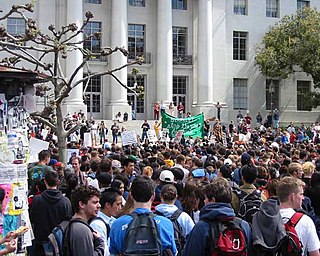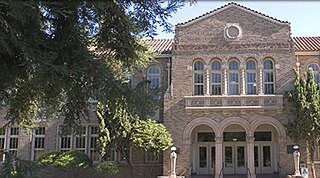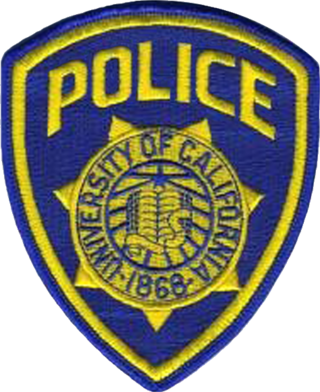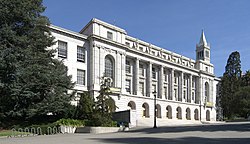
Berkeley is a city on the eastern shore of San Francisco Bay in northern Alameda County, California, United States. It is named after the 18th-century Anglo-Irish bishop and philosopher George Berkeley. It borders the cities of Oakland and Emeryville to the south and the city of Albany and the unincorporated community of Kensington to the north. Its eastern border with Contra Costa County generally follows the ridge of the Berkeley Hills. The 2020 census recorded a population of 124,321.

Sproul Plaza is one center of student activity at the University of California, Berkeley. It is divided into two sections: Upper Sproul and Lower Sproul. They are vertically separated by twelve feet (3.7 m) and linked by a set of stairs.

People's Park in Berkeley, California, is a plot of land that is owned by the University of California, Berkeley. Located east of Telegraph Avenue, bound by Haste and Bowditch Streets, and Dwight Way, People's Park was a symbol during the radical political activism of the late 1960s.

Arthur Brown Jr. (1874–1957) was an American architect, based in San Francisco and designer of many of its landmarks. He is known for his work with John Bakewell Jr. as Bakewell and Brown, along with later works after the partnership dissolved in 1927.

The University House is a residence and venue for official events on the campus of the University of California, Berkeley. Designed by the architect Albert Pissis and completed in 1911, it was formerly named President's House while it served as the home of the president of the University of California, starting with Benjamin Ide Wheeler and ending with Robert Gordon Sproul. Since 1965, it has been the home of the Chancellor of the Berkeley campus.

Robert Gordon Sproul was the first system-wide president (1952–1958) of the University of California system, and a president (11th) of the University of California, Berkeley, serving from 1930 to 1952.

John Galen Howard was an American architect and educator who began his career in New York before moving to California. He was the principal architect at several firms in both states and employed Julia Morgan early in her architectural career.

Evans Hall is the statistics, economics, and mathematics building on the campus of the University of California, Berkeley.
The campus of the University of California, Berkeley, and its surrounding community are home to a number of notable buildings by early 20th-century campus architect John Galen Howard, his peer Bernard Maybeck, and their colleague Julia Morgan. Subsequent tenures as supervising architect held by George W. Kelham and Arthur Brown, Jr. saw the addition of several buildings in neoclassical and other revival styles, while the building boom after World War II introduced modernist buildings by architects such as Vernon DeMars, Joseph Esherick, John Carl Warnecke, Gardner Dailey, Anshen & Allen, and Skidmore, Owings and Merrill. Recent decades have seen additions including the postmodernist Haas School of Business by Charles Willard Moore, Soda Hall by Edward Larrabee Barnes, and the East Asian Library by Tod Williams Billie Tsien Architects.

Turlock High School (THS) is a comprehensive high school located in Turlock, in the heart of the northern San Joaquin Valley in the U.S. state of California.

Dwinelle Hall is the second largest building on the campus of the University of California, Berkeley. It was completed in 1952, and is named after John W. Dwinelle, the state assemblyman responsible for the Organic Act that established the University of California in 1868 and one of the first Regents of the UC system. Dwinelle houses the departments of classics, rhetoric, linguistics, history, comparative literature, South and Southeast Asian studies, film studies, French, German, Italian studies, Scandinavian, Slavic languages, Spanish and Portuguese, and gender and women's studies.

Police departments in the University of California system are charged with providing law enforcement to each of the system's campuses.

Gilman Hall is a building on the campus of the University of California, Berkeley. Room 307 was where Glenn T. Seaborg and his coworkers identified plutonium as a new element on February 23, 1941 and as such, is designated a National Historic Landmark. The building itself is designated a National Historic Chemical Landmark, recognizing the two Nobel Prizes in Chemistry that have resulted from research done in the building.

South Hall is the oldest building on the campus of the University of California, Berkeley, built in 1873 in the Napoleon III style. It is the only remaining building of the original campus. South Hall was originally the counterpart of North Hall, which no longer exists, but was located where the Bancroft Library currently stands.
The history of the University of California, Los Angeles traces back to the 19th century when the institution operated as a teachers' college. It grew in size and scope for nearly four decades on two Los Angeles campuses before California governor William D. Stephens signed a bill into law in 1919 to establish the Southern Branch of the University of California. As the university broke ground for its new Westwood campus in 1927 and dissatisfaction grew for the "Southern Branch" name, the UC Regents formally adopted the "University of California at Los Angeles" name and "U.C.L.A." abbreviation that year. The "at" was removed in 1958 and "UCLA" without periods became the preferred stylization under Chancellor Franklin D. Murphy in the 1960s. In the first century after its founding, UCLA established itself as a leading research university with global impact across arts and culture, education, health care, technology and more.
The history of the University of California, Berkeley begins on October 13, 1849, with the adoption of the Constitution of California, which provided for the creation of a public university. On Charter Day, March 23, 1868, the signing of the Organic Act established the University of California, with the new institution inheriting the land and facilities of the private College of California and the federal funding eligibility of a public agricultural, mining, and mechanical arts college.
The 1960s Berkeley protests were a series of events at the University of California, Berkeley, and Berkeley, California. Many of these protests were a small part of the larger Free Speech Movement, which had national implications and constituted the onset of the counterculture of the 1960s. These protests were headed under the informal leadership of students Mario Savio, Jack Weinberg, Brian Turner, Bettina Aptheker, Steve Weissman, Art Goldberg, Jackie Goldberg, and others.
The 2009 California university college tuition hike protests were a series of protests held on college campuses in the University of California system and elsewhere in California in September 2009 through March 2010. The size of the protests at each campus varied with over 4,000 people at UC Berkeley and 20 at UC Merced. Protests were mostly made up of students, although faculty, school employees and others joined in the protests as well. Protestors were vocal against a tuition increase, pay cuts and other cutbacks following a budget deficit. The protests have been described as a precursor to the Occupy movement.
Cal Performances is the performing arts presenting, commissioning and producing organization based at the University of California, Berkeley in Berkeley, California.



















